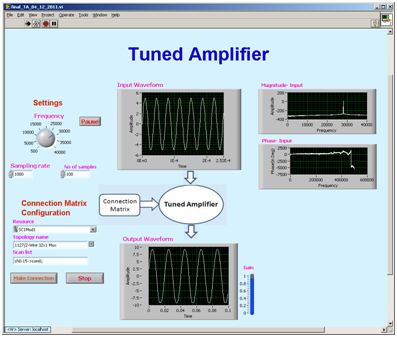- Internet Accessible Remote Laboratories
- Resources
- GUI Samples
- Tuned Amplifier
Tuned Amplifier
A tuned amplifier has a frequency response similar to that of a band-pass filter except with gain. In communications, tuned amplifiers are commonly used to separate a desired frequency from a composite waveform. As an example, broad tuned radio frequency amplifiers are used to block undesired frequencies, such as image frequencies, from entering a radio receiver, and intermediate frequency amplifiers separate and amplify a narrow band of signals for base band detection.
In this experiment, the gain-versus-frequency response characteristics of a class-A tuned amplifier are examined. The impedance of a tank circuit is a function of frequency with a maximum value at resonance. A tank circuit, placed in the collector of a class-A transistor amplifier, determines the frequency response characteristics of the amplifier. The AC collector resistance and consequently the voltage gain of the amplifier are maximum at the resonant frequency and decreases as frequency increases or decreases from resonance.
A user can change a few things: input frequency for the amplifier, choosing one of the four timing resistors so that the tuning frequency of the amplifier can be changed, and sampling rate and the number of samples for data collection.
